The Medical Devices Market is estimated to be valued at USD 678.9 billion in 2025 and is projected to reach USD 1215.8 billion by 2035, registering a compound annual growth rate (CAGR) of 6.0% over the forecast period.
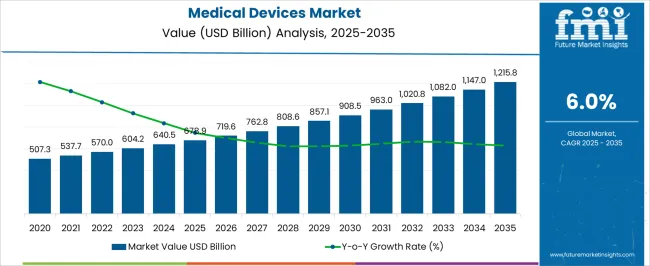
| Metric | Value |
|---|---|
| Medical Devices Market Estimated Value in (2025 E) | USD 678.9 billion |
| Medical Devices Market Forecast Value in (2035 F) | USD 1215.8 billion |
| Forecast CAGR (2025 to 2035) | 6.0% |
The medical devices market is experiencing steady growth driven by increasing demand for advanced diagnostic and therapeutic equipment across healthcare facilities worldwide. Rising prevalence of chronic diseases, aging populations, and expansion of healthcare infrastructure are significantly supporting market growth. Technological advancements in devices, coupled with increased focus on early disease detection and minimally invasive procedures, are enhancing treatment outcomes and operational efficiency.
Adoption of smart and connected medical devices is being facilitated by integration with electronic health records and telehealth platforms, allowing healthcare providers to monitor patient conditions in real time. Regulatory initiatives promoting high-quality and safe medical equipment are further shaping the market landscape. Growing investments in research and development are driving innovation in device accuracy, durability, and patient safety.
Hospitals and ambulatory surgical centers are increasingly procuring advanced equipment to improve service quality, optimize workflows, and reduce treatment costs As healthcare systems globally continue to modernize, the medical devices market is positioned for long-term expansion with continued opportunities in both diagnostic and therapeutic segments.
The medical devices market is segmented by type, end-user, and geographic regions. By type, medical devices market is divided into In-vitro Diagnostic (IVD), Orthopedic Devices, Cardiovascular Devices, Diagnostic Imaging Devices, Minimally Invasive Surgery Devices, Wound Management, Diabetes Care Devices, Ophthalmic Devices, Dental Devices, Nephrology Devices, General Surgery, and Others. In terms of end-user, medical devices market is classified into Hospitals & ASCs, Clinics, and Others. Regionally, the medical devices industry is classified into North America, Latin America, Western Europe, Eastern Europe, Balkan & Baltic Countries, Russia & Belarus, Central Asia, East Asia, South Asia & Pacific, and the Middle East & Africa.
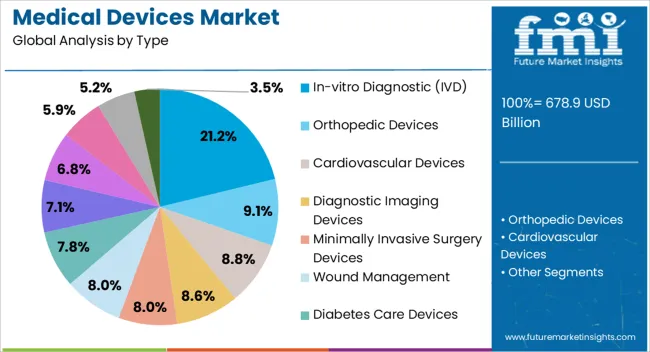
The in-vitro diagnostic type segment is projected to hold 21.2% of the medical devices market revenue share in 2025, establishing it as a leading product type. This leadership is being driven by the growing need for early disease detection and preventive healthcare across hospitals and clinical laboratories. IVD devices provide accurate, rapid, and cost-effective testing for a wide range of conditions, including infectious diseases, metabolic disorders, and cancers.
Their adoption is being facilitated by advancements in automation, molecular diagnostics, and point-of-care testing platforms, which improve throughput and diagnostic reliability. Hospitals and laboratories are increasingly integrating IVD systems into routine workflows to enhance patient outcomes and reduce diagnostic turnaround times. The segment benefits from continuous innovation that expands the range of detectable conditions, improves sensitivity and specificity, and reduces operational complexity.
Increasing awareness about preventive healthcare and government initiatives promoting laboratory diagnostics are further supporting adoption As healthcare providers continue to prioritize efficiency, accuracy, and compliance with international standards, the in-vitro diagnostic segment is expected to maintain strong growth and remain a key revenue contributor.
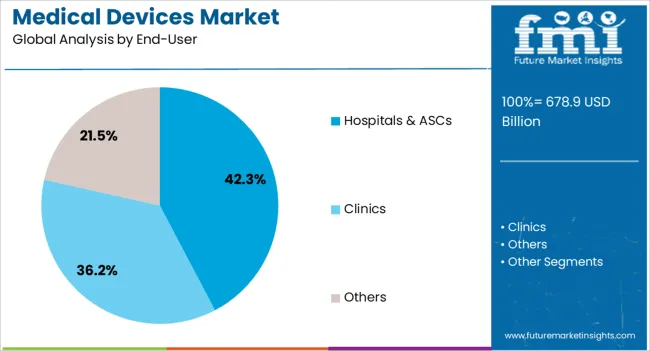
The hospitals and ambulatory surgical centers end-user segment is anticipated to account for 42.3% of the medical devices market revenue share in 2025, making it the largest end-user category. This dominance is being driven by the continuous expansion of hospital networks, increasing surgical volumes, and the need for comprehensive patient care across outpatient and inpatient settings. Hospitals and ASCs are increasingly procuring advanced medical devices that enable high-precision diagnostics, minimally invasive surgeries, and real-time patient monitoring.
Adoption is further supported by operational efficiency requirements, regulatory mandates, and the growing emphasis on improving patient outcomes while controlling costs. The segment benefits from the integration of medical devices with hospital information systems, enhancing workflow automation and enabling data-driven decision-making.
Rising investments in modernizing healthcare facilities and expanding capacity, particularly in emerging economies, are sustaining demand for high-quality devices As hospitals and ASCs continue to evolve as central hubs for diagnostic and therapeutic services, the reliance on sophisticated medical devices is expected to drive sustained growth and reinforce their leading position in the market.
Medical devices market is the fastest increasing market worldwide due to its extensive use in hospitals, research and development centers, educational institutes and clinical laboratories.
Medical devices market is majorly classified into seven categories including diagnostic imaging devices, drug delivery devices, molecular diagnostic, surgical devices, monitoring devices, bioimplants and neurostimulation, and others.
The medical devices market is showing continuous growth driven by various factors such as rise in aging population, innovations in medical devices, changing lifestyles and increasing awareness about the medical conditions and available treatments.
Diagnostic imaging devices segment is the major revenue generating market for medical devices market due to extensive research and development. Other major revenue segment for medical devices market is bioimplants and neurostimulation specifically in markets of North America and Europe due to increasing demand for cosmetic implants and economic stability in these regions.
North America leads in the medical devices market followed by the Europe majorly because of aging population. According to the data of Centers for Disease Control and Prevention (CDS), in 2010 40 million people aged 65 and above in United States accounting for 13% of the total population and CDC projected that around 20% of the population in the country would be under this category by 2035.
Market of Asia-Pacific is also growing at faster pace for medical devices majorly driven by the growing economies of Japan, China and India. The key players in the market include Stryker Corporation, Johnson & Johnson, Philips Healthcare, Siemens Healthcare, GE Healthcare, Toshiba Medical Systems, Boston Scientific Corporation, St. Jude Medical, Inc., Biomet, Inc. and Smith and Nephew. Among all of the above Stryker Corporation and Johnson & Johnson are currently dominating medical devices markets.
This research report presents a comprehensive assessment of the market and contains thoughtful insights, facts, historical data and statistically-supported and industry-validated market data and projections with a suitable set of assumptions and methodology. It provides analysis and information by categories such as market segments, regions, product types and distribution channels.
Market Segments
Market Dynamics
Historical Actual Market Size, 2025 - 2025
Market Size & Forecast 2025 to 2025
Supply & Demand Value Chain
Current Trends/Issues/Challenges
Competition & Companies involved
Technology
Value Chain
Market Drivers and Restraints
The report is a compilation of first-hand information, qualitative and quantitative assessment by industry analysts, inputs from industry experts and industry participants across the value chain.
The report provides in-depth analysis of parent market trends, macro-economic indicators and governing factors along with market attractiveness as per segments. The report also maps the qualitative impact of various market factors on market segments and geographies.
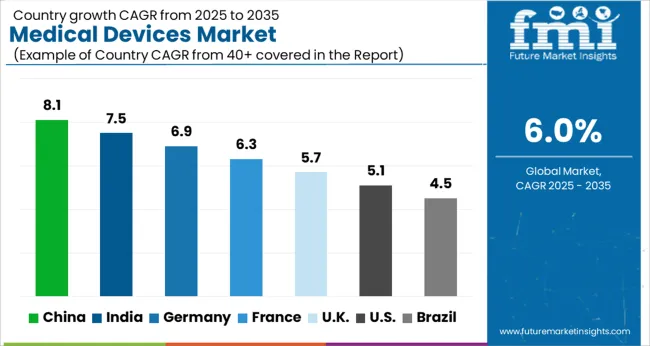
| Country | CAGR |
|---|---|
| China | 8.1% |
| India | 7.5% |
| Germany | 6.9% |
| France | 6.3% |
| UK | 5.7% |
| USA | 5.1% |
| Brazil | 4.5% |
The Medical Devices Market is expected to register a CAGR of 6.0% during the forecast period, exhibiting varied country level momentum. China leads with the highest CAGR of 8.1%, followed by India at 7.5%. Developed markets such as Germany, France, and the UK continue to expand steadily, while the USA is likely to grow at consistent rates. Brazil posts the lowest CAGR at 4.5%, yet still underscores a broadly positive trajectory for the global Medical Devices Market. In 2024, Germany held a dominant revenue in the Western Europe market and is expected to grow with a CAGR of 6.9%. The USA Medical Devices Market is estimated to be valued at USD 234.7 billion in 2025 and is anticipated to reach a valuation of USD 385.9 billion by 2035. Sales are projected to rise at a CAGR of 5.1% over the forecast period between 2025 and 2035. While Japan and South Korea markets are estimated to be valued at USD 31.5 billion and USD 18.0 billion respectively in 2025.
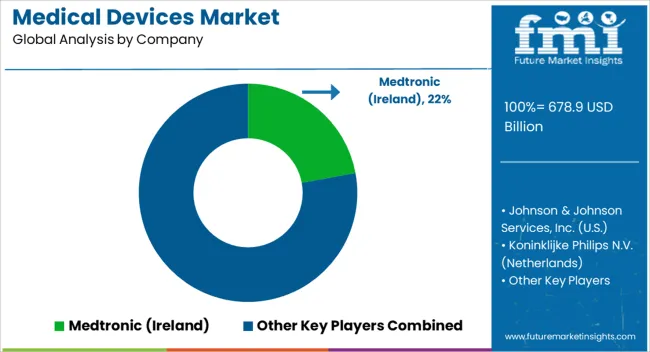
| Item | Value |
|---|---|
| Quantitative Units | USD 678.9 Billion |
| Type | In-vitro Diagnostic (IVD), Orthopedic Devices, Cardiovascular Devices, Diagnostic Imaging Devices, Minimally Invasive Surgery Devices, Wound Management, Diabetes Care Devices, Ophthalmic Devices, Dental Devices, Nephrology Devices, General Surgery, and Others |
| End-User | Hospitals & ASCs, Clinics, and Others |
| Regions Covered | North America, Europe, Asia-Pacific, Latin America, Middle East & Africa |
| Country Covered | United States, Canada, Germany, France, United Kingdom, China, Japan, India, Brazil, South Africa |
| Key Companies Profiled | Medtronic (Ireland), Johnson & Johnson Services, Inc. (USA), Koninklijke Philips N.V. (Netherlands), F. Hoffmann-La Roche Ltd. (Switzerland), Boston Scientific Corporation (USA), Fresenius Medical Care AG (Germany), GE Healthcare (USA), Siemens Healthineers AG (Germany), Stryker (USA), Abbott (USA), BD (USA), and Cardinal Health (USA) |
The global medical devices market is estimated to be valued at USD 678.9 billion in 2025.
The market size for the medical devices market is projected to reach USD 1,215.8 billion by 2035.
The medical devices market is expected to grow at a 6.0% CAGR between 2025 and 2035.
The key product types in medical devices market are in-vitro diagnostic (ivd), orthopedic devices, cardiovascular devices, diagnostic imaging devices, minimally invasive surgery devices, wound management, diabetes care devices, ophthalmic devices, dental devices, nephrology devices, general surgery and others.
In terms of end-user, hospitals & ascs segment to command 42.3% share in the medical devices market in 2025.






Our Research Products

The "Full Research Suite" delivers actionable market intel, deep dives on markets or technologies, so clients act faster, cut risk, and unlock growth.

The Leaderboard benchmarks and ranks top vendors, classifying them as Established Leaders, Leading Challengers, or Disruptors & Challengers.

Locates where complements amplify value and substitutes erode it, forecasting net impact by horizon

We deliver granular, decision-grade intel: market sizing, 5-year forecasts, pricing, adoption, usage, revenue, and operational KPIs—plus competitor tracking, regulation, and value chains—across 60 countries broadly.

Spot the shifts before they hit your P&L. We track inflection points, adoption curves, pricing moves, and ecosystem plays to show where demand is heading, why it is changing, and what to do next across high-growth markets and disruptive tech

Real-time reads of user behavior. We track shifting priorities, perceptions of today’s and next-gen services, and provider experience, then pace how fast tech moves from trial to adoption, blending buyer, consumer, and channel inputs with social signals (#WhySwitch, #UX).

Partner with our analyst team to build a custom report designed around your business priorities. From analysing market trends to assessing competitors or crafting bespoke datasets, we tailor insights to your needs.
Supplier Intelligence
Discovery & Profiling
Capacity & Footprint
Performance & Risk
Compliance & Governance
Commercial Readiness
Who Supplies Whom
Scorecards & Shortlists
Playbooks & Docs
Category Intelligence
Definition & Scope
Demand & Use Cases
Cost Drivers
Market Structure
Supply Chain Map
Trade & Policy
Operating Norms
Deliverables
Buyer Intelligence
Account Basics
Spend & Scope
Procurement Model
Vendor Requirements
Terms & Policies
Entry Strategy
Pain Points & Triggers
Outputs
Pricing Analysis
Benchmarks
Trends
Should-Cost
Indexation
Landed Cost
Commercial Terms
Deliverables
Brand Analysis
Positioning & Value Prop
Share & Presence
Customer Evidence
Go-to-Market
Digital & Reputation
Compliance & Trust
KPIs & Gaps
Outputs
Full Research Suite comprises of:
Market outlook & trends analysis
Interviews & case studies
Strategic recommendations
Vendor profiles & capabilities analysis
5-year forecasts
8 regions and 60+ country-level data splits
Market segment data splits
12 months of continuous data updates
DELIVERED AS:
PDF EXCEL ONLINE
Medical Devices Secondary Packaging Market Analysis by Material and Application Through 2035
Medical Cleaning Devices Market Overview - Trends & Forecast 2025 to 2035
Portable Medical Devices Market Analysis - Growth & Forecast 2025 to 2035
Homecare Medical Devices Market Outlook – Industry Growth & Forecast 2025 to 2035
AI-enabled Medical Devices Market Size and Share Forecast Outlook 2025 to 2035
3D Printed Medical Devices Market is segmented by drug type, treatment and distribution channel from 2025 to 2035
Reprocessed Medical Devices Market Size and Share Forecast Outlook 2025 to 2035
Antimicrobial-coated Medical Devices Market Size and Share Forecast Outlook 2025 to 2035
Asia Pacific Reprocessed Medical Devices Market Growth – Trends & Forecast 2025 to 2035
Medical Silicone Radiopaque Vascular Ties Market Size and Share Forecast Outlook 2025 to 2035
Medical Indoor Air Purifier Market Size and Share Forecast Outlook 2025 to 2035
Medical Eye Shield Film Market Size and Share Forecast Outlook 2025 to 2035
Medical Far Infrared Therapy Device Market Size and Share Forecast Outlook 2025 to 2035
Medical Latex Protective Suit Market Size and Share Forecast Outlook 2025 to 2035
Medical Activated Carbon Dressing Market Size and Share Forecast Outlook 2025 to 2035
Medical Coated Roll Stock Market Size and Share Forecast Outlook 2025 to 2035
Medical Billing Outsourcing Market Size and Share Forecast Outlook 2025 to 2035
Medical Pressure Mapping System Market Size and Share Forecast Outlook 2025 to 2035
Medical Chairs Market Size and Share Forecast Outlook 2025 to 2035
Medical Exoskeleton Market Forecast Outlook 2025 to 2035

Thank you!
You will receive an email from our Business Development Manager. Please be sure to check your SPAM/JUNK folder too.
Chat With
MaRIA